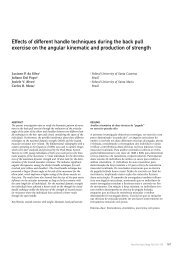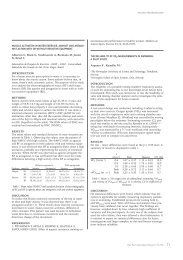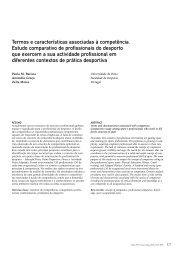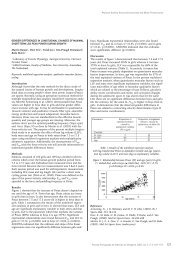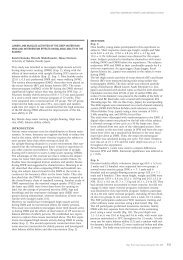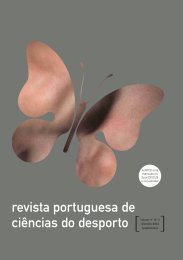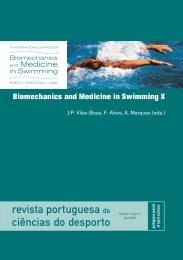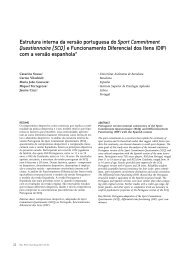35754-Revista FCDEF - Faculdade de Desporto da Universidade do ...
35754-Revista FCDEF - Faculdade de Desporto da Universidade do ...
35754-Revista FCDEF - Faculdade de Desporto da Universidade do ...
You also want an ePaper? Increase the reach of your titles
YUMPU automatically turns print PDFs into web optimized ePapers that Google loves.
Conclusões<br />
Os resulta<strong>do</strong>s <strong>do</strong> nosso estu<strong>do</strong> apontam no senti<strong>do</strong> <strong>de</strong> ser<br />
necessário aprofun<strong>da</strong>r os nossos conhecimentos sobre as percepções<br />
<strong>do</strong>s a<strong>do</strong>lescentes relativamente aos níveis <strong>de</strong> participação<br />
nas activi<strong>da</strong><strong>de</strong>s físicas. A priori, os <strong>da</strong><strong>do</strong>s sugerem que os<br />
indivíduos que têm uma participação inferior a três vezes por<br />
semana não têm benefícios, quan<strong>do</strong> compara<strong>do</strong>s com os que<br />
não têm qualquer tipo <strong>de</strong> activi<strong>da</strong><strong>de</strong> física, para além <strong>da</strong> que<br />
têm nas aulas <strong>de</strong> educação física.<br />
Ao contrário <strong>do</strong> que é sugeri<strong>do</strong> na literatura, os níveis <strong>de</strong> autoestima<br />
<strong>do</strong>s indivíduos <strong>do</strong> sexo masculino e <strong>do</strong> feminino são<br />
idênticos.<br />
Implicações para os profissionais <strong>de</strong> educação física<br />
Planear a<strong>de</strong>qua<strong>da</strong>mente a gestão <strong>do</strong>s feedback a serem presta<strong>do</strong>s<br />
durante as suas intervenções profissionais <strong>de</strong> mo<strong>do</strong> a que a<br />
educação física possa ser um agente interveniente como media<strong>do</strong>r<br />
na minimização <strong>do</strong> impacto negativo que existe em torno<br />
<strong>do</strong> “negócio <strong>do</strong> corpo” e assim:<br />
1. Promover comportamentos que estejam associa<strong>do</strong>s à saú<strong>de</strong>;<br />
2. Promover a activi<strong>da</strong><strong>de</strong> física e o exercício associa<strong>do</strong>s a valores<br />
sócio-culturais inerentes à saú<strong>de</strong>, apoio social e realização<br />
pessoal, para que a prática seja associa<strong>da</strong> a melhorias nos<br />
<strong>do</strong>mínios <strong>do</strong> bem-estar psicológico;<br />
3. Promover uma orientação cognitiva para a mestria, <strong>de</strong> forma<br />
a garantir o <strong>de</strong>senvolvimento <strong>do</strong> auto-controlo e <strong>da</strong> auto-responsabilização.<br />
Referências<br />
AMARAL-DIAS, C. & BRAVO, A. (2003). O inferno somos nós.<br />
Conversas sobre crianças e a<strong>do</strong>lescentes (2ª ed.). Lisboa: Quetzal<br />
Editores.<br />
ANASTÁCIO, Z. (2001). Educação sexual: Relacionamento entre<br />
pais e filhos a<strong>do</strong>lescentes. Tese <strong>de</strong> mestra<strong>do</strong> não publica<strong>da</strong>,<br />
Universi<strong>da</strong><strong>de</strong> <strong>de</strong> Trás-os-Montes e Alto Douro, Vila Real,<br />
Portugal.<br />
ANASTÁCIO, Z.; CARVALHO, G. & VASCONCELOS-RAPO-<br />
SO, J. (2003, Outubro). Influência <strong>da</strong> religião e <strong>da</strong> prática religiosa<br />
na satisfação com a imagem corporal e na auto-estima. 3ª<br />
Encontro Nacional <strong>de</strong> Promoção e Educação para a Saú<strong>de</strong>.<br />
Beja, Portugal.<br />
BATISTA, P. (1995). Satisfação com imagem corporal e auto-estima –<br />
Estu<strong>do</strong> comparativo <strong>de</strong> a<strong>do</strong>lescentes envolvi<strong>da</strong>s em diferentes níveis <strong>de</strong><br />
activi<strong>da</strong><strong>de</strong> física. Dissertação <strong>de</strong> <strong>do</strong>utoramento não publica<strong>da</strong>,<br />
<strong>FCDEF</strong> - Universi<strong>da</strong><strong>de</strong> <strong>do</strong> Porto, Portugal.<br />
BIDDLE, S. & MUTRIE, N. (2001). Psychology of physical activity:<br />
Determinants, well-being and interventions. Lon<strong>do</strong>n: Routledge.<br />
CASH, T. (2004). Body image: Past, present and future. Body<br />
Image 1, 1-5.<br />
COOPERSMITH, S. (1967). The antece<strong>de</strong>nts of self-esteem. San<br />
Francisco, CA: Freeman.<br />
CRUZ, T. M. (1998). Imagem corporal e auto-estima numa população<br />
clínica: Implicações para a promoção / educação para a saú<strong>de</strong>.<br />
Tese <strong>de</strong> mestra<strong>do</strong> não publica<strong>da</strong>, Universi<strong>da</strong><strong>de</strong> <strong>de</strong> Trás-os-<br />
Montes e Alto Douro, Vila Real, Portugal.<br />
DIENER, E.; SUH, E. & LUCAS, R. (1999). Subjective wellbeing:<br />
Three <strong>de</strong>ca<strong>de</strong>s of progress. Psychological Bulletin 125(2):<br />
276-302.<br />
DUKE-DUNCAN, P. (1991). Body image. In R. Lerner, A.<br />
Petersen & J. Brooks-Gunn (Eds.) Encyclopedie of A<strong>do</strong>lescence<br />
(Vol I). New York: Garland Publishing,90-94.<br />
DURKIN, S. & PAXTON, S. (2002). Predictors of vulnerability<br />
GRUPOS DE INTERESSE<br />
to reduced body image satisfaction and psychological wellbeing<br />
in response to exposure to i<strong>de</strong>alized female media images<br />
in a<strong>do</strong>lescent girls. Journal of Psychosomatic Research 53,<br />
995-1005.<br />
FOX, K. R. (2000). The effects of exercise on self-perceptions<br />
and self-esteem. In S. Biddle, K. Fox & S. Boutcher (Eds.)<br />
Physical activity and psychological well-being. Lon<strong>do</strong>n: Routledge,<br />
88-117.<br />
FRANZOI, S. & SHIELDS, S. (1984). The body esteem scale:<br />
Multidimensional structure and sex differences in a college<br />
population. Development Psychology 21 (1):90-96.<br />
GALLAHUE, D. & OZMUN, J. (2001). Compreen<strong>de</strong>n<strong>do</strong> o <strong>de</strong>senvolvimento<br />
motor - Bebês, crianças, a<strong>do</strong>lescentes e adultos. São<br />
Paulo: Phorte Editora.<br />
GROESZ, L.; LEVINE, M. & MURNEN, S. (2002). The experimental<br />
presentation of thin media images on body dissatisfaction:<br />
A meta-analytic review. International Journal of Eating<br />
Disor<strong>de</strong>rs 3, 1-16.<br />
HERMON, D. & HAZLER, R. (1999). Adherence to a wellness<br />
mo<strong>de</strong>l and perceptions of psychological well-being. Journal of<br />
Coounseling and Development 77, 339-343.<br />
LOPEZ, F. & FUERTES, A. (1999). Para compreen<strong>de</strong>r a sexuali<strong>da</strong><strong>de</strong>.<br />
Lisboa: APF.<br />
LUCAS, R.; DIENER, E. & SUH, E. (1996). Discriminant validity<br />
of well-being measures. Journal of Personality and Social<br />
Psychology 71, 616-628.<br />
MENDELSON, B. & WHITE, D. (1985). Development of selfbody-esteem<br />
in overweight youngsters. Developmental<br />
Psychology 21 (1):90-96.<br />
MENDELSON, M.; MENDELSON, B. & ANDREWS, J. (2000).<br />
Self-esteem, body-esteem, and body-mass in late a<strong>do</strong>lescence:<br />
Is a competence X importance mo<strong>de</strong>l nee<strong>de</strong>d? Journal of<br />
Applied Development Psychology 21 (3):279-266.<br />
MISRA, R. & AGUILLON, S. (2001). Predictors of health behaviors<br />
in rural a<strong>do</strong>lescents. Health Education 101 (1): 22-30.<br />
MOORE, S. & ROSENTHAL, D. (1995). Sexuality in a<strong>do</strong>lescence.<br />
Lon<strong>do</strong>n: Routledge.<br />
NICHTER, M. & NICHTER, M. (1991). Hype and weight.<br />
Medical Anthropology 13, 249-289.<br />
NOVO, R. (2003). Para além <strong>da</strong> Eu<strong>da</strong>imonia: O bem-estar psicológico<br />
em mulheres na i<strong>da</strong><strong>de</strong> adulta avança<strong>da</strong>. Lisboa: Fun<strong>da</strong>ção<br />
Calouste Gulbenkian.<br />
NURMI, J.; POOLE, M. & KALAKOSKI, V. (1996). Age diferences<br />
in a<strong>do</strong>lescent i<strong>de</strong>ntity exploration and in urban and<br />
rural <strong>de</strong>velopment. Journal of A<strong>do</strong>lescence 21, 443-452.<br />
RAUST-VON WRIGHT, M. (1989). Body image satisfaction in<br />
a<strong>do</strong>lescent girls and boys: A longitudinal study. Journal of<br />
Youth and A<strong>do</strong>lescence 18, 71-83.<br />
ROSENBERG, M. (1965). Society and the A<strong>do</strong>lescent Self-Image.<br />
Princeton, NJ: University Press.<br />
SASTRE, M. (1999). Lay conceptions of well-being and rules<br />
used in well-being judgements among young, middle-aged,<br />
and el<strong>de</strong>rly adults. Social Indicators Research 47, 203-231.<br />
SCRIVEN, A. & STIDDARD, L. (2003). Empowering schools:<br />
Translating health promotion principles into practice. Health<br />
Education 103 (2):110-118.<br />
SONSTOEM, R. J. (1997). Physical activity and self-esteem. In<br />
W. P. Morgan (Ed.) Physical activity and mental health.<br />
Washington, D.C.: Taylor and Francis, 127-147.<br />
SONSTROEM, R. J. (1984). Exercise and self-esteem. Exercise<br />
and Sport Sciences Review 12, 123-155.<br />
STEPTOE, A. & BUTLER, N. (1996). Sports participation and<br />
<strong>Revista</strong> Portuguesa <strong>de</strong> Ciências <strong>do</strong> <strong>Desporto</strong>, 2004, vol. 4, nº 2 (suplemento) [15–102] 49



